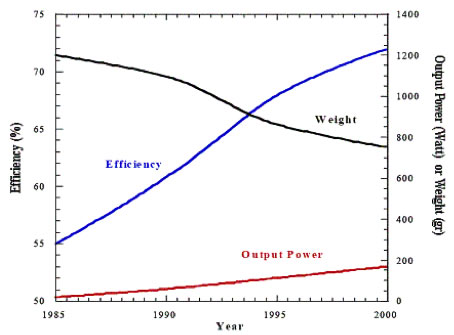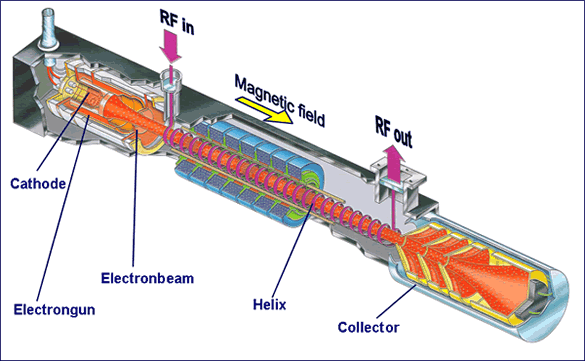TWTs are widely used in telecommunications, for instance radar systems and satellite transponders employ them as amplifiers. According to recently published papers, solid-state power amplifiers (SSPAs) cannot compete with TWTs when it comes to outputting
power in the megawatt region at frequencies in the range of 26.5 - 40GHz (Ka Band).

Furthermore, SSPAs only have an efficiency of about 15 – 20 percent whereas TWTs typically achieve 70 percent efficiency . For satellite transponders, where increasing the efficiency by 1 percent can potentially earn $30M more profit throughout its lifetime of about 15 years. As a result, they are certainly the only choice in the foreseeable future.
The graph on the right shows the Efficiency(%) and Output Power(Watt) or Weight(gr) against Time.(Caption:Efficiency, Output Power and Weight against Time.)
In a TWT, electrons are emitted by an electron gun at one end. As they pass through the tube, these electrons are accelerated and are focused into a beam before entering the tube. It then travels across the helix until it reaches the collector at the other end.
A radio frequency (RF) signal is injected from the input, and propagates through the helix coil (known as a slow-wave structure) inside the tube until it reaches the output. The RF wave is able to gain kinetic energy from the electrons; in essence, it is amplified.
The figure on the right shows the inner structure of a Travelling wave tube.
The helix coil elongates the path the RF wave travels so it is able to synchronize with the electron beam. The current induced by the RF wave interacts with the electron beam, so it builds up the helix current as it travels through the tube.
The amplified RF travels through the waveguide to the output at the other end of the tube closer to the collector.The attenuator is positioned in the middle of the tube to prevent the wave from travelling back to the input.
Further Readings/ References:
1. http://hadmernok.hu/archivum/2007/2/2007_2_balajti.html
